#enterprise ux design
Text
Best Practices for Enterprise UX Design
User experience (UX) design plays a crucial role in the success of any organization, particularly in the context of large enterprises. As the digital landscape continues to evolve, creating a seamless and intuitive user interface (UI) and user experience is vital for engaging customers, increasing productivity, and driving business growth. In the realm of enterprise UX design, there are several best practices that can significantly enhance the user experience within large organizations.
Understand the User Journey: One of the fundamental principles of enterprise UX design is to thoroughly understand the user journey within the organization's digital ecosystem. This involves mapping out the various touchpoints, from initial interaction to task completion, and identifying pain points and opportunities for improvement. By gaining a deep understanding of the user journey, designers can create intuitive interfaces and experiences that align with users' needs and expectations, ultimately enhancing overall satisfaction and productivity.
Consistency Across Platforms: Large organizations often have a diverse range of digital platforms and applications. Maintaining consistency in the UI/UX design across these platforms is essential for creating a cohesive and familiar experience for users. This can be achieved through standardized design elements, such as typography, color schemes, and interaction patterns, as well as a unified design language that reflects the organization's brand identity. Consistency across platforms not only improves usability but also reinforces the organization's credibility and professionalism.
Accessibility and Inclusivity: Inclusive design is a critical aspect of enterprise UX, particularly in large organizations with diverse user bases. Designing with accessibility in mind ensures that all users, including those with disabilities, can effectively interact with digital products and services. This involves incorporating features such as screen reader compatibility, keyboard navigation, and color contrast considerations. By prioritizing accessibility, organizations can foster a more inclusive and equitable user experience for all individuals, regardless of their abilities.
User-Centric Data Security: In the context of enterprise UX design, data security and privacy are paramount considerations. Designing interfaces that prioritize user-centric data security involves implementing clear and transparent privacy settings, secure authentication processes, and proactive measures to protect sensitive information. By integrating robust security features into the UX design, organizations can instill trust and confidence in users, ultimately enhancing the overall user experience.
Iterative Testing and Feedback: Continuous testing and gathering user feedback are integral components of effective enterprise UX design. Large organizations can benefit from implementing iterative design processes that involve usability testing, user feedback sessions, and data-driven insights. By leveraging feedback from diverse user groups and stakeholders, designers can refine and optimize the UI and UX to better meet the evolving needs and preferences of the organization's user base.
Collaboration and Alignment: Effective enterprise UX design requires close collaboration and alignment across multidisciplinary teams, including designers, developers, product managers, and stakeholders. By fostering a culture of collaboration and open communication, organizations can ensure that UX design decisions are aligned with business goals, technical feasibility, and user needs. This collaborative approach facilitates the creation of cohesive and impactful user experiences that drive value for both the organization and its users.
In conclusion, enterprise UX design is a multifaceted discipline that demands a strategic and user-centric approach to creating engaging and efficient digital experiences within large organizations. By embracing best practices such as understanding the user journey, maintaining consistency across platforms, prioritizing accessibility, ensuring user-centric data security, leveraging iterative testing and feedback, and fostering collaboration and alignment, organizations can elevate their UX design efforts and deliver exceptional user experiences that drive business success. As the digital landscape continues to evolve, prioritizing enterprise UX design will be pivotal in shaping the future of user interactions within large organizations.
Experience the transformative power of exceptional UX design with Galaxy ux studio. Elevate your organization's digital presence, drive user engagement, and unlock new opportunities for growth with our expertise in Digital UI/UX design and development. Let's collaborate to create intuitive, accessible, and visually stunning user experiences that set your organization apart. Contact Galaxy UX Studio today to embark on a journey towards unparalleled UX design excellence.
4 notes
·
View notes
Text
Enterprise UX: A Comprehensive Guide
Dive into the world of Enterprise UX design with our latest article. Discover the crucial role of user-centric design in enhancing productivity, reducing errors, and boosting satisfaction within large organizations. Explore best practices, understand the significance of a streamlined interface, and unravel the challenges designers face in creating efficient, user-friendly experiences for diverse enterprise users.
0 notes
Text
Market Insight: Mobile Responsive (SaaS)

Hello Tumblr's!
We present our newly designed interactive candlestick chart. We once again went for a black-themed design as it makes it easy for the eyes! Also the design is mobile friendly along PCs!
We attempted to understand every feature a trader needs to make their operations smooth and add them to our design. If you are interested more of the these, here's the link to similar designs we created for the stock market and analytics:
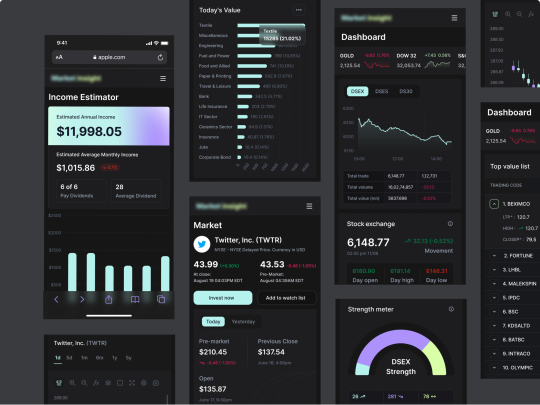
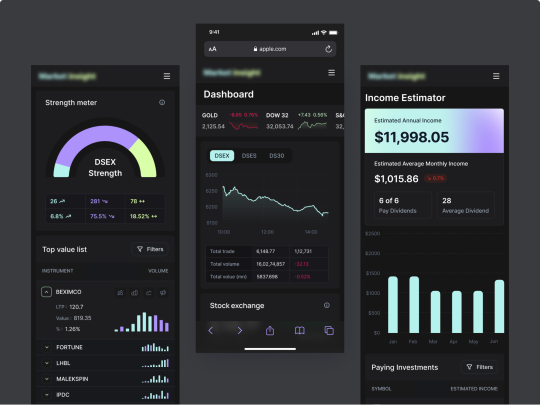
Сheck out more 👉 https://dribbble.com/shots/19898686-Market-Insight-Mobile-Responsive-SaaS
We are top-notch design agency focusing on UI/UX design, web design, branding & marketing ✌️
We’re available for new projects: [email protected]
Visit us: Website | Dribbble| Linkedin | Behance | Twitter | Medium | Instagram
#saas#mobile app#appdesign#dashboard#datavisualization#enterprise software#ui ux design#statistics#designagency#musemind
3 notes
·
View notes
Text
Web & App Development Company USA | Enterprise Solutions Provider| Ivotiontech
Ivotiontech is a leading web & app development company in USA, specialized in enterprise solutions, software outsourcing, digital marketing & more. Get quality services from experienced developers with UI/UX design & Magento development.
#Web Development Company USA#Mobile App Development Company USA#UI/UX Design Company USA#Magento development services#Front-End Development Services#Enterprise Services company India#Software Outsourcing#Digital Marketing Company in USA
1 note
·
View note
Text
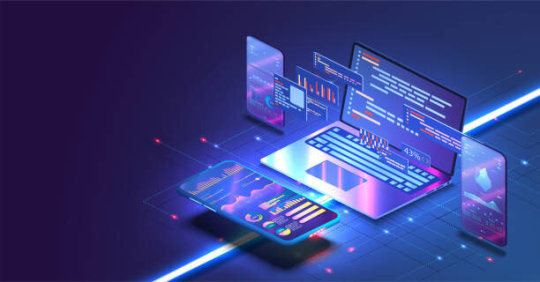
Enterprise App Development
Enterprise app development focuses on creating applications tailored to meet the specific needs of businesses and organizations. These apps often streamline internal processes, enhance productivity, and facilitate communication within the enterprise environment!
#App Development#Mobile App Development#Web App Development#Cross-Platform App Development#Enterprise App Development#iOS App Development#Android App Development#UI/UX Design for Mobile Apps#https://www.techaheadcorp.com/blog/app-development/
0 notes
Text
Software development is the process of creating, designing, testing, and sustaining software systems or applications. As a result, the software developer writes the code to solve specific problems or satisfy the requirements of a software design company. The goal of software development is to create excellent software that meets user needs and expectations.
#Software Developer#Software Engineer#Software Design Company#enterprise software development services#Best Software Development Company in Noida#best ui ux design software#ui ux design firms#best software for ui ux design
0 notes
Text

Unleash unparalleled user experiences with F1 STUDIOZ, the epitome of excellence in enterprise UX design in the USA. Elevate your digital presence as our seasoned experts blend innovation and functionality, ensuring optimal interactions. Partner with F1 STUDIOZ for a transformative journey that redefines user engagement and sets your enterprise apart in the competitive landscape of user experience design.
0 notes
Text
HS Digital Media Crafting Compelling Narratives through Ad Films
The Power of Ad Films

Why Choose HS Digital Media
Showcase your company’s unique selling characteristics. Highlight any awards, recognition, or successful case studies.
The Creative Process
Provide insights into how HS Digital Media approaches ad film creation. Discuss the collaboration between your team and clients. Emphasize the importance of tailoring each project to the client’s brand and goals.
Technological Edge
Detail the cutting-edge technology and equipment used by HS Digital Media. Discuss any innovative techniques or trends in the ad film industry.
The Team Behind the Magic
Introduce key members of your team and their expertise. Share any success stories or challenges overcome during previous projects.
Client Success Stories
Include testimonials from satisfied clients. Highlight specific projects and their impact on the client’s brand.
Industry Trends and Insights
Discuss current trends in ad film production. Share insights into the evolving landscape of digital media.
Challenges and Solutions
Address common challenges in ad film production. Showcase how HS Digital Media overcomes these challenges to deliver exceptional results.
Social Impact Through Ad Films
Discuss any projects that have contributed to social causes. Highlight the potential for ad films to create positive change.
The Future of Ad Films
Share your vision for the future of ad film production. Discuss emerging technologies and their potential impact on the industry.
#Mobile App Development#App Development Services#iOS App Development#Android App Development#Custom Mobile App#Mobile Application Design#Cross-Platform App Development Native App Development Mobile App Developers#Mobile App UI/UX#Mobile App Testing#Enterprise App Development#Mobile App Prototyping#App Maintenance Services#Mobile App Security#Cloud-Based App Development#Mobile App Integration#Wearable App Development#AR/VR App Development#IoT App Development#Mobile App Development Mumbai#Mumbai App Developers#iOS App Development Mumbai#Android App Development Mumbai#Mobile App Design Mumbai#Mumbai Mobile App Agency#Mumbai App Development Services#Custom App Development Mumbai#Mumbai Mobile App Solutions#Native App Development Mumbai#Cross-Platform App Mumbai#Mobile App Testing Mumbai
0 notes
Text
Key Benefits and Strategies to Implement for Enterprises
In today's fast-paced business environment, enterprises continually strive for innovation and efficiency to remain competitive. PerfectionGeeks Technologies, a leading provider of innovative solutions, has been at the forefront of helping enterprises achieve their goals. This comprehensive article will delve into the key benefits and strategies that PerfectionGeeks Technologies offers enterprises. We will explore how these solutions empower organizations to thrive in digital transformation.
Visit us:
#Strategies to Implement for Enterprises#blockchain application development#ios app development#website development company#website design services#iot development services#ui and ux design service
0 notes
Text
A web portal's most vital aspect relies on its significant UI/UX design, responsible for attracting and driving a more targeted audience towards it. Having an advanced and fast responsive UI/UX design carries long-term merits, making it way better for the business branding.
Key components of an ideal web portal design include these major factors, explained in the blog here:
Smooth, Authentic and easy Single-Sign-In option
Attractive layout & Seamless navigation
Quicker content and workflow management
High-responsive collaboration
Want to have your own business web portal design with all these features?
Contact Aixtir now and get the best digital transformation based solutions at the best cost-effective options!
0 notes
Link
An all-around enterprise mobile applications takes care of the genuine issues of genuine clients with the assistance of client research. In the growing technological era, mobile applications have turned into a never-ending pattern.
#Designing Enterprise Applications#Business Cycles and Functionalities#Data Optimization#UX Configuration#App Development Process#Corporate Business Application#Enterprise App Development Company#Enterprise Mobile App Solutions#App Development Methodology#Mobile Application Development#Enterprises Mobile Application Market
1 note
·
View note
Text
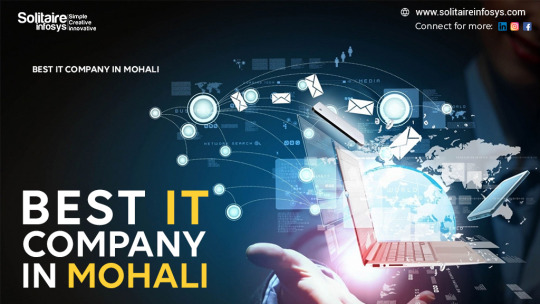
Best Internship Training Provider in Mohali for Coding and Non-Coding Interns. 6weeks and 6 months internship training Under UI&UX Designing, Mobile Applications, Digital Marketing, Web Development ,Enterprise Applications and Support & Maintenance - Solitaire Infosys
#itcompany#websitedevelopment#mobile application development#digital marketing#enterprise application development#internship#indstrial training#training#6 months#6 weeks#6 week industrial training#6 month industrial training#infosys#solitaire infosys#ui&ux#designing#internship opportunity in chandigarh#Chandigarh industrial training#industrial training in mohali#mohali best industrial training#best industrial training in mohali#best it training in tricity
1 note
·
View note
Audio
As a mid-to-large-sized enterprise company, your company website is incredibly essential for your business to succeed.
A staggering 75% of your business’s credibility comes from your website design, and as an enterprise company, your credibility, faith, and authority represent everything.
An enterprise website design will:-
Build a strong online presence that makes credibility, trust, and authority for your company
Make strong calls to action that draw visitors to take the next step in the buyer journey
Ensure to offer of a mobile-friendly website for users on all devices
Make sure your website navigation is easy for users to find what they require
Ensure to offer of easy-to-submit forms to facilitate users to share their details
Offer a seamless check-out procedure
For reaping these amazing advantages from your enterprise website design, you should think of working with an experienced website development agency in Mohali that knows everything about your niche and has experience handling companies like yours!
Your enterprise website template
So, what should your enterprise website design have? What are the most essential factors of your enterprise website design?
Here is my recommended enterprise website design template to assist you to make sure success with your website.
A robust brand
If you consider some of the most prominent companies in the world, they evolve successfully by having a strong brand. They choose the right color scheme from the beginning, selected their brand tone and aesthetic, and adhered to it.
When you have a powerful brand, you should do the following to make sure your website design is branded well:-
Ensure to follow a color scheme
Utilize the same logo in every location on the website
Write with the exact tone and style
These small aspects will assist you to build a cohesive brand that you can always utilize throughout the life of your enterprise.
Clear navigation
The next important factor on the checklist is website navigation. It is one of the most essential factors as without easy-to-use navigation it can be quite confusing for users to know where to know and which pages to visit or how to get what they looking for.
Clear and easy-to-use website navigation will assist in keeping visitors on your company website longer, which is a positive sign for Google. Because users can easily discover what they’re looking for, you’ll lower the bounce rate since users will probably visit numerous pages on your website.
Mobile-friendly design
Every website on Google should be developed with mobile in mind — especially because of Google’s mobile-first index.
Google peeks at the mobile version of your company website before anything else, so your website must be made both for mobile and desktop users. Owning a mobile-friendly website signifies that no matter what device a user experiences on your website, they’ll have the same positive experience.
Buttons should be as easy to click on a mobile screen as they are to click on a desktop computer. Pictures should have the same grade.
Conversion conscious
Without a conversion-conscious enterprise website design, you’ll see fewer sales and lower income year over year.
A conversion-conscious website design contains design factors or elements that assist users to navigate down the marketing funnel. A few of these design elements are listed below:-
Calls-to-action (CTAs): Your CTAs should be precise and clear, and make visible what you like users to do next. Ensure you use CTAs on every page of your website.
Contact forms: Contact forms take visitors to another level of the marketing funnel. After they feed their contact information, they’re now believed to be an interested buyer — and you have their contact details to persist in marketing to them.
Add Phone numbers with one-click calling: Making sure that you have your firm’s phone number in plain sight is necessary. Make it easy for visitors to find your phone number, and effortless for them to click to call.
0 notes
Text
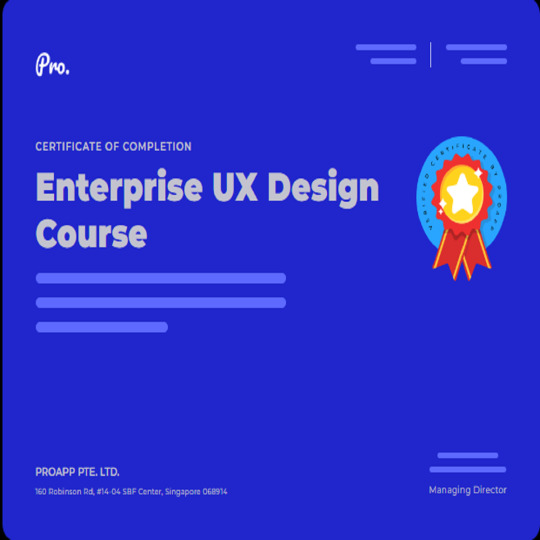
ProApp Design is the market leader in enterprise UX design training. They specialise in teaching students the fundamentals of user experience (UX) design, including everything from research and wireframing to prototyping and usability testing. ProApp Design's comprehensive curriculum provides a thorough education in UX design best practises, giving students a competitive edge in the workforce.
Their certification program adheres to industry standards and provides comprehensive instruction on how to create successful digital products with a focus on user-centered design. Through hands-on exercises, lectures, case studies, and self-directed projects, students enrolled in ProApp Design's coursework learn how to create high-quality experiences for web and mobile applications. They not only teach the principles of UX design, but they also provide the practical tools required to succeed as a UX designer.
ProApp places a high value on delivering an exceptional user experience. Their team places a high value on developing intuitive and simple-to-use designs that help users simplify complex tasks. ProApp understands the importance of collaboration in enterprise UX design.
Given below are some of the goals of Enterprise UX
1. Performance
Employees expect an app to respond quickly because no one likes to wait. This is especially important in a commercial setting because if the software is slow or difficult to use, hours are lost and productivity suffers.
2. Functionality
Routine tasks should be automated and simplified, allowing personnel to concentrate on more complex issues.
3. Integration, Portability, And Compatibility
Because manual data transfer requires a tremendous amount of effort given the current amount of information, the program should easily support different data transfer formats.
4. Reliability
Errors in the system’s operation can be extremely harmful to both users and the company. Nobody is going to be happy with inaccurate computations or data loss.
5. Simplicity And Convenience
Even the most efficient and well-functioning platform will not be able to optimise a company’s work if users are unable to use it. The primary goal of a business application is to make it easy to use.
Meaning of Enterprise UX
Enterprise UX is a new design concept with no widely accepted definition. Despite the fact that many industrial UX manuals have different definitions, reaching consensus among them is difficult.
The design of software program that serve very large businesses and large numbers of users is referred to as enterprise UX.
The Enterprise UX process aims to understand people's needs, goals, drivers, and pain points as they go about their daily lives, resulting in a more.
Who should participate in this training?
This course is especially interesting for people with the following profiles:
Members of a project or full-stack developers who want to learn about UX Design so they can incorporate it into their daily work.
Colleagues in an Company with little or no knowledge of UX but who want to learn the fundamentals.
UX designers looking to expand their knowledge.
0 notes
Text
Web App Development
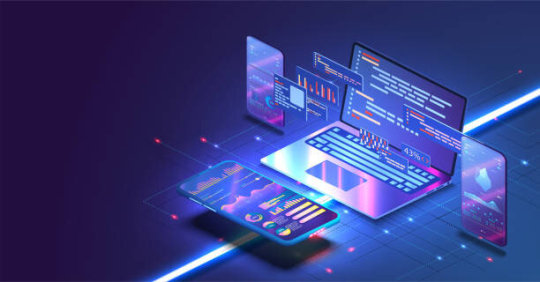
What Is App Development? A Beginner’s Guide To App Development Basics And Its Types
App development has emerged as a pivotal force, transforming how we interact with our devices. Originating back in 1983 with Steve Jobs’ creation of a rudimentary version. Besides, app development has grown into a sophisticated process that is crucial in streamlining business operations and enhancing user experiences. The ubiquity of mobile applications in today’s world is staggering. Recent statistics reveal that a substantial 21 percent of millennials open an app more than 50 times a day, underlining the pervasive influence of these digital tools in our daily lives.
However, the competitive landscape is intense, with the Apple App Store boasting 4.567 million apps and games and the Google Play Store boasting 3.57 million by July 2022. So, what exactly is app development? At its core, app development is chiefly the intricate process through which developers craft applications designed for smartphones, tablets, and other mobile devices. While web-based and desktop applications are part of the development spectrum, the primary focus remains on creating solutions tailored for the mobile and tablet ecosystem. This article delves into the multifaceted app development world, unraveling the features and considerations that define its essence. So dive in, as we are about to unravel the various intricacies of app development.
App Development Stages
App development is akin to orchestrating a symphony of creativity, technology, and meticulous planning. Moreover, understanding the key stages in this intricate process is crucial for entrepreneurs seeking growth solutions and eager to align with industry experts. In this section, we unveil the sequential phases that form the backbone of app development, shedding light on the app development process and expertise essential for success.
1. Crafting a Vision
Every successful app development endeavor commences with a crucial phase — Project Initiation. This stage involves ideation, requirements analysis, and the discovery phase. When a client approaches us with their business needs, objectives, and product vision, the engagement manager collaborates to shape a comprehensive understanding. For projects with vague concepts, our Discovery phase service aids in refining requirements, estimating costs, and aligning the project with market trends. Therefore the result is a coherent project picture, enabling our expert team to conduct detailed requirement specifications and garner client agreement.
2. Requirements Analysis
Requirements Analysis marks a pivotal point where we delve into the intricate details of end users’ needs. From high-level business requirements to detailed system specifications, our analysis ensures a seamless alignment with user expectations. So this phase bridges the client’s vision and the execution of a functional, user-centric application. Project estimation becomes paramount, encompassing timelines, costs, workforce requirements, and resource allocation to pave the way for successful project planning.
3. Focus on Planning and Mitigating Risks
Effective planning is undoubtedly the cornerstone of mitigating risks, avoiding uncertainties, and ensuring project success. By addressing concerns such as missing features, rebuilds, and overwork, our teams achieve clarity on project deliverables and timelines. Planning goes beyond scheduling product deadlines; it involves continuous, incremental assessments, providing flexibility for adjustments as needed. Moreover, our meticulous planning reduces risks, avoids uncertainty, makes informed decisions, establishes trust, and conveys transparent information to our clients.
4. Prototyping and Design
Prototyping and Design form the creative heartbeat of app development. Through rapid prototyping, we visualize the initial design sketches, fostering a shared vision with our clients. UI/UX designers then weave their magic, incorporating seamless transitions, animations, and intuitive interfaces into the app’s design. This phase bridges the conceptual and the tangible, guiding the transition from design to production, ultimately culminating in the coding phase.
5. Development Process
Development is more than coding; it’s a strategic orchestration of tasks and priorities. Task prioritization, estimation, and collaboration between software engineers, UI/UX designers, and quality assurance engineers are crucial components of this phase.
6. Testing and QA
Scrum is a framework for iterative development cycles or sprints in the agile methodology. Scrum facilitates a focused, uninterrupted work environment, ensuring the team delivers tangible results within specified periods. Regular meetings for iteration cycle planning, status updates, and sprint reviews drive collaboration and adaptability. Using tools like Jira, our teams categorize tasks, ensuring a seamless flow from development to testing. Undoubtedly the importance of acceptance criteria shines through, guiding the project to completion with precision and quality.
What Are the Types of Application Development?
The key categories that define the landscape of app development are:
Mobile App Development
Cross-Platform App Development
Web App Development
Enterprise App Development
Here is a brief overview of each mobile app development type.
1. Mobile App Development
Mobile app development is the art of crafting applications specifically designed for smartphones, tablets, and other handheld devices. These applications cater to the on-the-go lifestyle of users and leverage the unique features of mobile devices. Whether it’s an Android or iOS platform, mobile app development involves creating seamless, user-friendly experiences tailored to the mobile ecosystem.
2. Web App Development
Web app development brings applications to life on web browsers, allowing users to access them through the internet. These platform-independent applications offer flexibility and accessibility across various devices and operating systems. Web apps often serve as efficient solutions for businesses looking to reach a broad audience without the need for users to download and install specific software.
3. Cross-Platform App Development
Cross-platform app development aims to bridge the gap between different operating systems, enabling applications to run smoothly on multiple platforms. This approach reduces development time and costs, as the development team can write code once and deploy it across various platforms. Technologies like React Native, Flutter, and Xamarin have emerged as powerful tools in the cross-platform development landscape.
4. Enterprise App Development
Enterprise app development caters to the unique needs of businesses, focusing on enhancing internal processes, improving productivity, and fostering seamless communication. These applications often integrate with existing enterprise systems, providing a tailored solution for the specific challenges organizations face. From customer relationship management (CRM) apps to business process automation, enterprise app development is pivotal in driving corporate efficiency.
Mobile App Development
In mobile app development, two giants, Android and iOS, reign supreme, powering most smartphones and tablets globally. Understanding the nuances of these platforms is pivotal. Let’s delve into the intricacies of Android and iOS app development, unraveling the unique features, trends, and considerations that define these ecosystems.
Android App Development
Android, the behemoth of the mobile operating system industry, has etched its dominance with a global market share of around 70.29% as of 2023. Developed by the Open Handset Alliance and later acquired by Google, Android boasts a user-friendly interface, robust community support, and extensive customization options. Its versatility extends beyond smartphones, encompassing tablets, wearables, set-top boxes, smart TVs, and more. Android app development demands a keen understanding of Java and Kotlin programming languages. Developers work collaboratively with UI/UX designers and quality assurance engineers, utilizing a technology stack defined at the project’s outset. Regular client meetings and iterative development cycles ensure transparency and alignment with project goals. The use of common languages and cross-platform tools facilitates code sharing and deployment across diverse devices.
Considerations
Fragmentation: Android’s diverse ecosystem introduces device fragmentation challenges, requiring developers to optimize apps for various screen sizes and hardware specifications.
Market Reach: With a vast global user base, Android offers expansive market reach, making it an attractive platform for businesses aiming to reach diverse audiences.
iOS App Development
iOS, Apple’s proprietary mobile operating system, powers iPhones, iPads, and iPod Touch devices. iOS app development involves writing software in Swift or Objective-C, languages designed to deliver seamless performance and security. The iOS ecosystem is renowned for its stringent quality review process, ensuring that only high-quality apps make their way to the App Store. Swift, introduced in 2014, is the primary language for iOS app development, offering a simpler syntax and enhanced security. Developers leverage Swift’s efficiency to create immersive user experiences, taking advantage of Apple’s hardware capabilities. The iOS development environment is known for its meticulous attention to design aesthetics and user interface, ensuring a premium user experience.
Considerations
Exclusivity: iOS mobile apps are exclusive to Apple’s ecosystem, limiting market reach compared to Android. However, iOS users tend to be more engaged and willing to spend on premium apps.
Hardware Integration: iOS app developers harness the unique features of Apple devices, such as the iPhone’s Face ID or iPad’s Apple Pencil, to create innovative and immersive applications.
Choosing the Right Path
As you embark on your mobile app development journey, the choice between Android and iOS hinges on various factors, including your target audience, project scope, and business objectives. Each platform offers distinct advantages, and selecting the right path requires careful consideration. If you want to develop apps suitable for Android and IOS, you can consider cross-platform app development, which we will cover in the next section.
Cross-Platform App Development
Catering to diverse platforms is a common challenge faced by companies aiming for widespread accessibility. The prevalence of iOS and Android devices in the consumer market requires a strategic approach to ensure the app reaches a broad audience.
The Dual Challenge: iOS and Android
With the U.S. consumer market divided nearly equally between Apple and Android users, the need to create mobile applications seamlessly operating on both platforms is evident. Traditionally, companies would opt for native development, employing separate teams for iOS and Android. While this approach provides proximity to each platform, it introduces significant challenges:
Code Duplication: Native development results in two distinct code bases, one for iOS and another for Android. Changes or updates require individual attention and testing for both, escalating maintenance efforts.
Resource Intensiveness: Hiring native developers from a more limited talent pool adds to the overall development cost. The need for specialized expertise for each platform contributes to resource-intensive projects.
Consistency Concerns: Maintaining a consistent user experience across iOS and Android platforms requires meticulous alignment with platform-specific design patterns.
Cross-Platform App Development Frameworks: A Solution
Cross-platform app development frameworks have emerged as a viable solution to address these challenges. These frameworks allow developers to build mobile applications from a single codebase, targeting multiple platforms simultaneously. Here are some popular frameworks leading the cross-platform development landscape:
1. Flutter
Developed by Google
Programming Language: Dart
Notable Apps: eBay, Alibaba, Google Pay, ByteDance apps
Key Features: Hot reload for instant code changes, Material Design support, and independent rendering engine.
2. React Native
Developed by Meta Platforms (formerly Facebook)
Programming Language: JavaScript
Notable Apps: Skype, Bloomberg, Shopify, various Facebook and Instagram modules
Key Features: Fast Refresh for immediate component changes, focus on UI responsiveness, strong developer community.
3. Xamarin
Owned by Microsoft
Programming Language: C#
Notable Apps: UPS, Alaska Airlines, Academy Members (Academy of Motion Picture Arts and Sciences)
Key Features: Utilizes .NET BCL for comprehensive features, Xamarin.Forms for consistent UI, compiled bindings for improved performance.
Choosing the Right Framework for Your Project
While these frameworks offer potent solutions, the choice depends on specific project requirements, goals, and other factors unique to your development endeavor. Considerations such as programming language preferences, project scale, and community support are crucial in determining the ideal framework for your cross-platform app development.
Web Application Development
Web applications have become integral tools that provide dynamic user experiences and serve as valuable insights for businesses. So, a web app is an interactive program accessed through a web browser running on a web server. Unlike traditional web pages, web applications prioritize user experience, leveraging an application program interface (API) to gather substantial user data. This data, encompassing customer interests, usage patterns, and preferences, becomes a goldmine for product refinement and targeted marketing strategies.
Distinguishing Features
User-Centric Design: User experience and user interface dictate the design of web applications, ensuring that interactions are intuitive and tailored to user preferences.
API Integration: Web applications employ APIs to gather and process large-scale user data, enabling automation and personalized experiences.
Front-End and Back-End Dynamics
Understanding the front-end and back-end dynamics is pivotal in web application development:
Front End
It involves the part of the web app that interacts with end-users.
Focuses on UI/UX design, SEO optimization, and enhancing performance.
Back End
Encompasses the background functioning of the web application.
Manages server handling, site architecture, database, security, and URL routing.
Enterprise App Development
In the fast-paced realm of enterprise-sized businesses, the role of technology in streamlining operations and enhancing productivity cannot be overstated. Enterprise app development emerges as a strategic initiative, focusing on crafting customized applications to address specific business needs. Let’s delve into the world of enterprise app development, exploring its nuances and the common categories that define this dynamic landscape.
Defining Enterprise App Development
At its core, enterprise app development is the meticulous process of creating applications tailored for large-scale businesses. These applications, once developed, serve the crucial purpose of addressing common pain points, automating workflows, and providing users with efficient tools to perform tasks seamlessly. The end goal is not just to develop an app but to create a solution that aligns with the unique requirements of enterprise-sized organizations.
Categories of Enterprise Mobile Apps
Enterprise mobile apps are categorized based on their organizational scope and impact. Understanding these categories provides insights into how these apps contribute to organizational efficiency:
1. Employee Level Apps
For Example: Slack
Purpose: Internal communication and workflow management
Features: Real-time updates and integrations for enhanced productivity.
2. Department Level Apps
For Example: CRM (Customer Relationship Management)
Purpose: Workflow enhancement for specific departments (e.g., sales, marketing)
Features: Productivity monitoring and comprehensive task tracking.
3. Enterprise Level Apps
For Example: Inventory Management Apps
Purpose: Connect all departments, simplify distribution and automation of work
Features: Centralized document access, real-time tracking, and alerts.
Types of Enterprise Applications
Enterprise app development encompasses various types, each serving a specific organizational function. So Here are some notable types:
1. Asset Management Apps
Function: Record and track assets throughout their life cycle.
Benefits: Enhanced visibility, utilization insights, and streamlined asset tracking.
2. HRMS (Human Resource Management System) Apps
Function: Store employee information and support HR functions.
Benefits: Automation of recruiting, training, benefits, and payroll processes.
3. Procurement Apps
Function: Provide complete control over purchasing activities.
Benefits: Consolidated purchasing information, fostering visibility and transparency.
4. Customer Support Apps
Function: Assist support agents in helping customers.
Benefits: Quick answers, troubleshooting support, and issue resolution.
5. Sales Apps
Function: Streamline and optimize sales processes.
Benefits: Marketing new products, informing customers about discounts, and speeding up sales operations.
Empowering Enterprise Growth Through Technology
Enterprise app development is a strategic investment in leveraging technology to enhance operational efficiency, automate workflows, and facilitate informed decision-making. In conclusion, as enterprises navigate the complexities of modern business environments, the role of custom applications becomes increasingly pivotal. For enterprises seeking innovative and impactful app solutions tailored to their unique needs, Techahead stands as a trusted partner. Explore our expertise in crafting enterprise applications that not only empower growth but also enhance your business efficiency.
Conclusion
In conclusion, as the demand for seamless user experiences continues to soar, app developers play a pivotal role in orchestrating creativity, technology, and meticulous planning. Whether you’re creating a mobile app to cater to the on-the-go lifestyle or an enterprise solution to enhance internal processes, the realm of app development offers limitless possibilities. Therefore choosing the right development path, be it native Android or iOS, cross-platform frameworks like Flutter or React Native, or the specialized realm of enterprise applications, demands careful consideration aligned with your project goals. Contact TechAhead today for all your web and mobile app development needs!
#https://www.techaheadcorp.com/blog/app-development/#App Development#Mobile App Development#Web App Development#Cross-Platform App Development#Enterprise App Development#iOS App Development#Android App Development#UI/UX Design for Mobile Apps
0 notes
Link
As per a recent report by Failory, around 80-90% of startups fail within a period of first ten years & it happens due to tough competition. And hence, there is a need to implement a future-proof plan to launch your product-based startup with a custom software solution that works.
Now take your time to uncover the factors responsible for the failure of tech startups before we bring our software product development guide to your rescue.
Also, find the quick guide to software product development for startups, Head to the link!
#Enterprise software development#UI/UX Design company#Blockchain developments#cost for app development#Fintech App Development#Plaid vs Onfido#Robinhood like App
0 notes